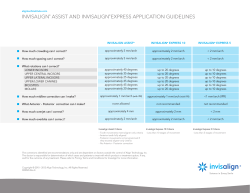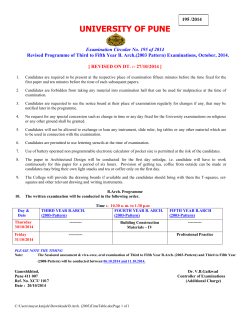
Pharyngeal Arches, Pouches and Clefts By: Dr. Mujahid Khan
Pharyngeal Arches, Pouches and Clefts By: Dr. Mujahid Khan Pharyngeal Apparatus The head and neck region of four week human embryo somewhat resemble these regions of a fish embryo of comparable stage This explains the former use of designation branchial apparatus Branchial is derived from the Greek word branchia or gill Pharyngeal Apparatus Pharyngeal apparatus consists of: Pharyngeal arches Pharyngeal pouches Pharyngeal grooves Pharyngeal membrane Pharyngeal Arches Pharyngeal arches begin to develop early in the fourth week as neural crest cells migrate into the head and neck region The first pair of pharyngeal arches (primordium of jaws) appears as a surface elevations lateral to the developing pharynx Soon other arches appear as obliquely disposed, rounded ridges on each side of the future head and neck regions Pharyngeal Arches By the end of the fourth week, four pairs of pharyngeal arches are visible externally The fifth and sixth arches are rudimentary and are not visible on the surface of the embryo The pharyngeal arches are separated from each other by fissures called pharyngeal grooves They are numbered in craniocaudal sequence Pharyngeal Arch Components Each pharyngeal arch consists of a core of mesenchyme Is covered externally by ectoderm and internally by endoderm In the third week the original mesenchyme is derived from mesoderm During the fourth week most of the mesenchyme is derived from neural crest cells that migrate into the pharyngeal arches Fate of Pharyngeal Arches The pharyngeal arches contribute exclusively to the formation the face, nasal cavities, mouth, larynx, pharynx and neck During the fifth week, the second pharyngeal arch enlarges and overgrows the third and fourth arches, forming the ectodermal depression called cervical sinus By the end of seventh week the second to fourth pharyngeal grooves and the cervical sinus have disappeared, giving the neck a smooth contour Fate of Pharyngeal Arches A typical pharyngeal arch contains: An aortic arch, an artery that arises from the truncus arteriosus of the primordial heart A cartilaginous rod that forms the skeleton of the arch A muscular component that differentiates into muscles in the head and neck A nerve that supplies the mucosa and muscles derived from the arch Pharyngeal Arches The first pharyngeal arch (mandibular arch) develops maxillary and mandibular prominences The first pair of pharyngeal arches plays a major role in facial development The second pharyngeal arch (hyoid arch) contributes to the formation of hyoid bone Derivatives of Pharyngeal Arch Cartilages The dorsal end of first arch cartilage (Meckel cartilage) ossifies to form malleus and incus The middle part of cartilage forms anterior ligament of malleus sphenomandibular ligament Ventral part of the first arch cartilages form primordium of the mandible The cartilage disappears as mandible develops around it Derivatives of Pharyngeal Arch Cartilages The dorsal end of second arch cartilage (Reichert cartilage) ossifies to form the stapes and styloid process of the temporal bone The ventral end of second arch cartilage ossifies to form the lesser cornu and superior part of the body of the hyoid bone Its perichondrium forms the stylohyoid ligament Derivatives of Pharyngeal Arch Cartilages The third arch cartilage ossifies to form the greater cornu and the inferior part of the body of the hyoid bone The fourth and sixth arch cartilages fuse to form the laryngeal cartilages except epiglottis which develops from hypopharyngeal eminence The fifth pharyngeal arch is rudimentary and has no derivatives Derivatives of Pharyngeal Arch Muscles The musculature of the first pharyngeal arch forms the muscles of mastication The second pharyngeal arch forms the stapedius, stylohyoid, posterior belly of digastric, auricular and muscles of facial expression The third arch forms the stylopharyngeus The fourth arch forms cricothyroid, levator veli palatini and constrictors of pharynx Sixth pharyngeal arch forms the intrinsic muscles of the larynx Derivatives of Pharyngeal Arch Nerves Caudal two branches of Trigeminal nerve (maxillary and mandibular) supply derivatives of the first pharyngeal arch The facial, glossopharyngeal and vagus nerves supply the second, third and caudal (fourth to sixth) arches respectively The fourth arch is supplied by superior laryngeal branch of vagus nerve The sixth arch is supplied by its recurrent laryngeal branch Pharyngeal Pouches The primordial pharynx, derived from the foregut, widens cranially where it joins the primordial mouth or stomodeum It narrows caudally where it joins the esophagus The endoderm of the pharynx lines the internal aspects of pharyngeal arches and passes into balloonlike diverticula called pharyngeal pouches Pharyngeal Pouches The pairs of pouches develop in a craniocaudal sequence between the arches The first pair of pouches lies between the first and second pharyngeal arches There are four well defined pairs of pharyngeal pouches The fifth pair is absent or rudimentary Pharyngeal Pouches The endoderm of the pouches contacts the ectoderm of the pharyngeal grooves and together they form the double layered pharyngeal membranes that separate the pharyngeal pouches from the pharyngeal grooves Derivatives of First Pharyngeal Pouch The first pharyngeal pouch expands into an elongate tubotympanic recess The expanded distal part of this recess contacts the first pharyngeal groove, where it contributes to the formation of the tympanic membrane (eardrum) The cavity of the tubotympanic recess gives rise to the tympanic cavity and mastoid antrum Derivatives of Second Pharyngeal Pouch The second pharyngeal pouch is largely obliterated as the palatine tonsils develop Part of the cavity of this pouch remains as the tonsillar sinus or fossa The endoderm of the pouch proliferates and grows into the underlying mesenchyme The central parts of these buds form crypts Derivatives of Second Pharyngeal Pouch The pouch endoderm forms the surface epithelium and the lining of the tonsillar crypts At about 20 weeks the mesenchyme around the crypts differentiates into lymphoid tissue These tissues soon organizes into the lymphatic nodules of the palatine tonsil Derivatives of Third Pharyngeal Pouch The third pharyngeal pouch expands and develops a solid, dorsal bulbar part and a hollow elongate ventral part Its connection with the pharynx is reduced to a narrow duct that soon degenerates By the sixth week the epithelium of each dorsal bulbar part begins to differentiate into inferior parathyroid gland Derivatives of Third Pharyngeal Pouch The epithelium of the elongate ventral parts of third pharyngeal pouch proliferates and their cavities obliterate These bilateral primordia of thymus come together in the median plane to form thymus It descends into the superior mediastenum The bilobed form of thymus remains throughout life Discretely encapsulated and each lobe has its own blood supply, lymphatic drainage and nerve supply Derivatives of Third Pharyngeal Pouch The primordia of thymus and parathyroid glands lose their connections with the pharynx and migrate into the neck Later the parathyroid glands separate from the thymus and lie on the dorsal surface of the thyroid gland Derivatives of Fourth Pharyngeal Pouch The fourth pharyngeal pouch also expands into dorsal bulbar and elongate ventral parts Its connection with the pharynx is reduced to a narrow duct that soon degenerates By the sixth week, each dorsal part develops into a superior parathyroid gland It lies on the dorsal surface of the thyroid gland Derivatives of Fourth Pharyngeal Pouch The parathyroid glands derived from the third pouches descend with the thymus and are carried to a more inferior position than the parathyroid derived from the fourth pouches This explains why the parathyroid glands derived from the third pair of pouches are located inferior to those from the fourth pouches Histogenesis of Parathyroid Gland The epithelium of the dorsal parts of the third and fourth pouches proliferates during the fifth week Forms small nodules on the dorsal aspect of each pouch Vascular mesenchyme soon grows into these nodules, forming capillary network The chief or principal cells differentiate during the embryonic period and regulate fetal calcium metabolism The oxiphil cells differentiate 5 to 7 years after birth Histogenesis of Parathyroid Gland The elongated ventral part of each fourth pouch develops into ultimopharyngeal body Its cells disseminate within the thyroid gland, giving rise to parafollicular cells They are also called “C” cells because they produce calcitonin that regulate normal calcium level in body fluids “C” cells differentiate from neural crest cells The Fifth Pharyngeal Pouch When this develops, this rudimentary pouch becomes part of the fourth pharyngeal pouch and helps to form the ultimopharyngeal body Pharyngeal Grooves During the fourth and fifth weeks, head and neck region of the human embryo exhibit four pharyngeal grooves or clefts on each side These grooves separate the pharyngeal arches externally Only first pair persists as the external acoustic meatus The other grooves normally obliterated with the cervical sinus as the neck develops Pharyngeal Membranes Pharyngeal membranes appear in the floor of the pharyngeal grooves These membranes form where the epithelia of the grooves and pouches approach each other The endoderm of the pouches and ectoderm of the grooves are soon separated by mesenchyme Only first pharyngeal membrane becomes the tympanic membrane, others obliterate
© Copyright 2025









